Cleopatra and the Society of Architects
Authors: Bruno Cathala & Ludovic Maublanc
Publisher: Days of Wonderr
Year: 2006
review by

| x |
|
|
|
|
|
|
|
|
|
|
|
|
|
|
|
|
|
|
|
|
|
|
|
|
|
|
|
|
|
|
|
|
|
|
|
|
|
|
|
|
|
|
|
|
|
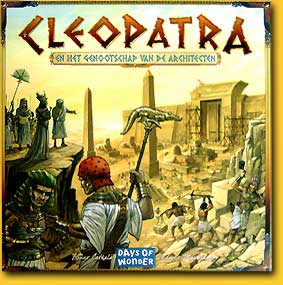 |
|
It is hard times for the contracting parties of building palaces! First they have to build a palace with everything that goes with it for a very demanding lady on very short notice, after which the one person who has a bit too obvious done business with questionable intermediates concerning the delivery of building materials will be thrown in the local oasis crocodile pool. Attracted by the reward in Talents from the heritage of the Pharao, three to five players gather in mutual envy around the building excavation where the palace must loom up. |
|
|
|
|
|
|
|
|
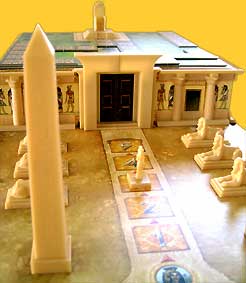 |
| However, we do not have to care about everything, as the basic building already has been built; we drop in so to say during the building and mainly take care of the ornaments. There are six categories that we have to take care of: the obelisks as pegs at the start of the drive, the garden gnomes that they call sfinxes over here, the mosaic tile floor, the decoration next to the entry of Cleopatra’s Ponderosa, the pillar walls as nostalgic added element, and the cosy garden chair back in the palm garden on the second floor. |
|
| x |
|
|
|
|
|
|
|
|
|
|
|
|
|
|
|
|
|
|
|
|
|
|
|
|
|
|
|
|
|
|
|
|
|
|
|
|
|
|
|
|
|
|
|
|
|
|
|
|
Once we know what our job consists of the next question arises: where to get the necessary building materials to get the stuff delivered and installed? For this reason we go to the market, scanty represented by three rows of cards as opposed to the rest of the game components, where the rows each can have a different amount of cards that represent craftsmen and materials, some of them are open, others blind that are refilled from a stack of preshuffled blind/open cards. Each to be built category has a different prerequisite of building materials, but all of them need the craftsmen. So just take your van from the garage to pick them up! |
| x |
|
|
|
|
|
|
|
|
|
|
|
|
|
|
|
|
|
|
|
|
|
|
|
|
|
|
|
|
|
|
|
|
|
|
|
|
|
|
|
|
|
|
|
|
|
Two things simultaneously, we remember this from our rather classic-conventional but nowadays not everywhere evenly broad employed education, this won’t work, so in our turn we can either go to the market to claim materials, or we visit the quarry and deliver a part at the palace. Delivering more parts is allowed, and it will get us a bonus in Talents, but this takes costly materials, and we only have space in our hands for ten cards. If we want to hold more, we have to pay for each card with a corruption marker.
We put these markers in a small Egyptian piggy bank that has the shape of a piramid. Our fellow players would like to see how much we already have collected but this is considered classified company information only known to ourselves. |
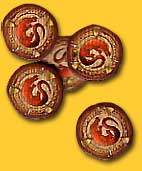 |
| x |
|
|
|
|
|
|
|
|
|
|
|
|
|
|
|
|
|
|
|
|
|
|
|
|
|
|
|
|
|
|
|
|
|
|
|
|
|
|
|
|
|
|
|
|
|
|
|
More corruption markers are collected in our piramid when we play certain building materials cards. The meager comfort may be that with these cards twice the building materials can be claimed, or, when they are character cards, give us a variety of advantages on building. |
| x |
|
|
|
|
|
|
|
|
|
|
|
|
|
|
|
|
|
|
|
|
|
|
|
|
|
|
|
|
|
|
|
|
|
|
|
|
|
|
|
|
|
|
|
|
|
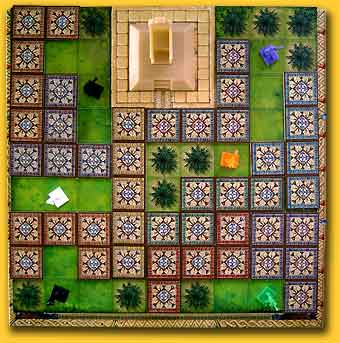 |
The collection of corruption markers can quickly get out of hand. Can’t we dispose them, then? Yes, maybe! One condition is that we must have built a mosaic tile in the garden, and in doing so, enclosing a space of empty squares with other mosaic tiles or the edge and that no other to be built tile can be put in this area. When a player puts one of his two available Anubis statues in it, at the end of the game for every square in this area he may put a corruption marker from his piramid on it. Despite this the possibilities are restricted, and each player pursues it: not participating in the garden is no option, as at least it gives you the option of disposing at least three or four collected corruption markers. |
| x |
|
|
|
|
|
|
|
|
|
|
|
|
|
|
|
|
|
|
|
|
|
|
|
|
|
|
|
|
|
|
|
|
|
|
|
|
|
|
|
|
|
|
|
|
|
| An other possibility to dispose corruption markers is to offer enough Talents to the High Priest. But when, and how often this happens is determined by chance. Every time when a building part has been added to the palace, five dice are rolled, each of them having just one symbol side. When it shows this symbol side, it is put aside. At the moment that a player in his turn has rolled the fifth symbol on the last die, all players take part in a secret bidding in Talents. The player with the higest bid may dispose three corruption markers from his piramid; but the other players collect from one to four corruption markers, and all players lose their bids! |
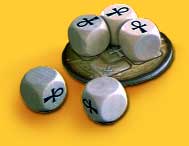 |
| x |
|
|
|
|
|
|
|
|
|
|
|
|
|
|
|
|
|
|
|
|
|
|
|
|
|
|
|
|
|
|
|
|
|
|
|
|
|
|
|
|
|
|
|
|
|
 |
|
|
|
|
|
|
|
|
|
|
|
|
|
|
|
|
|
|
|
|
|
|
|
|
|
|
|
|
|
|
|
|
|
|
|
|
|
|
|
|
|
 |
|
|
|
|
|
|
|
|
|
|
|
|
|
|
|
|
|
|
|
|
|
|
|
|
|
|
|
|
|
|
|
|
|
|
|
|
|
|
|
|
|
 |
|
|
|
|
|
|
|
|
|
|
|
|
|
|
|
|
|
|
|
|
|
|
|
|
|
|
|
|
|
|
|
|
|
|
|
|
|
|
|
|
|
| x |
|
|
|
|
|
|
|
|
|
|
|
|
|
|
|
|
|
|
|
|
|
|
|
|
|
|
|
|
|
|
|
|
|
|
|
|
|
|
|
|
|
|
|
|
|
 |
|
|
|
|
|
|
|
|
|
|
|
|
|
|
|
|
|
|
|
|
|
|
|
|
|
|
|
|
|
|
|
|
|
 |
|
|
|
|
|
|
|
|
|
|
|
|
|
|
|
|
|
|
|
|
|
|
|
|
|
|
|
|
|
|
|
|
|
|
|